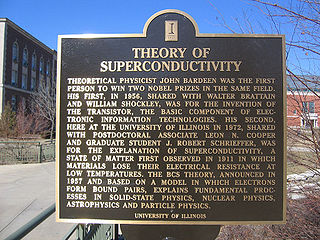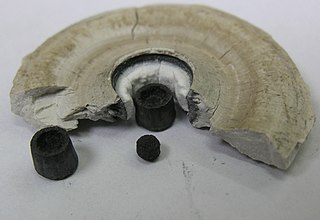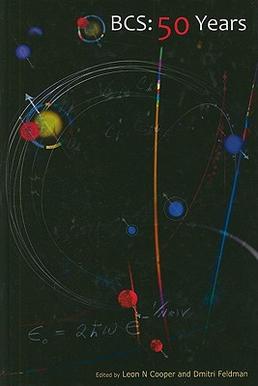Related Research Articles

In physics, theBardeen–Cooper–Schrieffer (BCS) theory is the first microscopic theory of superconductivity since Heike Kamerlingh Onnes's 1911 discovery. The theory describes superconductivity as a microscopic effect caused by a condensation of Cooper pairs. The theory is also used in nuclear physics to describe the pairing interaction between nucleons in an atomic nucleus.

Condensed matter physics is the field of physics that deals with the macroscopic and microscopic physical properties of matter, especially the solid and liquid phases that arise from electromagnetic forces between atoms and electrons. More generally, the subject deals with condensed phases of matter: systems of many constituents with strong interactions among them. More exotic condensed phases include the superconducting phase exhibited by certain materials at extremely low cryogenic temperatures, the ferromagnetic and antiferromagnetic phases of spins on crystal lattices of atoms, the Bose–Einstein condensates found in ultracold atomic systems, and liquid crystals. Condensed matter physicists seek to understand the behavior of these phases by experiments to measure various material properties, and by applying the physical laws of quantum mechanics, electromagnetism, statistical mechanics, and other physics theories to develop mathematical models and predict the properties of extremely large groups of atoms.
Unconventional superconductors are materials that display superconductivity which does not conform to conventional BCS theory or its extensions.

High-temperature superconductors are defined as materials with critical temperature above 77 K, the boiling point of liquid nitrogen. They are only "high-temperature" relative to previously known superconductors, which function at even colder temperatures, close to absolute zero. The "high temperatures" are still far below ambient, and therefore require cooling. The first break through of high-temperature superconductor was discovered in 1986 by IBM researchers Georg Bednorz and K. Alex Müller. Although the critical temperature is around 35.1 K, this new type of superconductor was readily modified by Ching-Wu Chu to make the first high-temperature superconductor with critical temperature 93 K. Bednorz and Müller were awarded the Nobel Prize in Physics in 1987 "for their important break-through in the discovery of superconductivity in ceramic materials". Most high-Tc materials are type-II superconductors.

Fermi liquid theory is a theoretical model of interacting fermions that describes the normal state of the conduction electrons in most metals at sufficiently low temperatures. The theory describes the behavior of many-body systems of particles in which the interactions between particles may be strong. The phenomenological theory of Fermi liquids was introduced by the Soviet physicist Lev Davidovich Landau in 1956, and later developed by Alexei Abrikosov and Isaak Khalatnikov using diagrammatic perturbation theory. The theory explains why some of the properties of an interacting fermion system are very similar to those of the ideal Fermi gas, and why other properties differ.
Color superconductivity is a phenomenon where matter carries color charge without loss, on analogy to the way conventional superconductors can carry electric charge without loss. Color superconductivity is predicted to occur in quark matter if the baryon density is sufficiently high (i.e., well above the density and energies of an atomic nucleus) and the temperature is not too high (well below 1012 kelvins). Color superconducting phases are to be contrasted with the normal phase of quark matter, which is just a weakly interacting Fermi liquid of quarks.
Frank Steglich is a German physicist and the founding director of the Max Planck Institute for Chemical Physics of Solids in Dresden, Germany.
In Materials Science, heavy fermion materials are a specific type of intermetallic compound, containing elements with 4f or 5f electrons in unfilled electron bands. Electrons are one type of fermion, and when they are found in such materials, they are sometimes referred to as heavy electrons. Heavy fermion materials have a low-temperature specific heat whose linear term is up to 1000 times larger than the value expected from the free electron model. The properties of the heavy fermion compounds often derive from the partly filled f-orbitals of rare-earth or actinide ions, which behave like localized magnetic moments. The name "heavy fermion" comes from the fact that the fermion behaves as if it has an effective mass greater than its rest mass. In the case of electrons, below a characteristic temperature (typically 10 K), the conduction electrons in these metallic compounds behave as if they had an effective mass up to 1000 times the free particle mass. This large effective mass is also reflected in a large contribution to the resistivity from electron-electron scattering via the Kadowaki–Woods ratio. Heavy fermion behavior has been found in a broad variety of states including metallic, superconducting, insulating and magnetic states. Characteristic examples are CeCu6, CeAl3, CeCu2Si2, YbAl3, UBe13 and UPt3.

Covalent superconductors are superconducting materials where the atoms are linked by covalent bonds. The first such material was boron-doped synthetic diamond grown by the high-pressure high-temperature (HPHT) method. The discovery had no practical importance, but surprised most scientists as superconductivity had not been observed in covalent semiconductors, including diamond and silicon.

The 122 iron arsenide unconventional superconductors are part of a new class of iron-based superconductors. They form in the tetragonal I4/mmm, ThCr2Si2 type, crystal structure. The shorthand name "122" comes from their stoichiometry; the 122s have the chemical formula AEFe2Pn2, where AE stands for alkaline earth metal (Ca, Ba Sr or Eu) and Pn is pnictide (As, P, etc.). These materials become superconducting under pressure and also upon doping. The maximum superconducting transition temperature found to date is 38 K in the Ba0.6K0.4Fe2As2. The microscopic description of superconductivity in the 122s is yet unclear.

Piers Coleman is a British-born theoretical physicist, working in the field of theoretical condensed matter physics. Coleman is professor of physics at Rutgers University in New Jersey and at Royal Holloway, University of London.
Heavy fermion superconductors are a type of unconventional superconductor.
The Fulde–Ferrell–Larkin–Ovchinnikov (FFLO) phase can arise in a superconductor in large magnetic field. Among its characteristics are Cooper pairs with nonzero total momentum and a spatially non-uniform order parameter, leading to normal conducting areas in the superconductor.
In condensed matter physics, a quantum spin liquid is a phase of matter that can be formed by interacting quantum spins in certain magnetic materials. Quantum spin liquids (QSL) are generally characterized by their long-range quantum entanglement, fractionalized excitations, and absence of ordinary magnetic order.

BCS: 50 Years is a review volume edited by Leon Cooper, a 1972 Nobel Laureate in Physics, and Dmitri Feldman of Brown University, first published in 2010.
CeCoIn5 ("Cerium-Cobalt-Indium 5") is a heavy-fermion superconductor with a layered crystal structure, with somewhat two-dimensional electronic transport properties. The critical temperature of 2.3 K is the highest among all of the Ce-based heavy-fermion superconductors.
Gilbert "Gil" George Lonzarich is a solid-state physicist who works at the Cavendish Laboratory at the University of Cambridge. He is particularly noted for his work on superconducting and magnetic materials.
Several hundred metals, compounds, alloys and ceramics possess the property of superconductivity at low temperatures. The SU(2) color quark matter adjoins the list of superconducting systems. Although it is a mathematical abstraction, its properties are believed to be closely related to the SU(3) color quark matter, which exists in nature when ordinary matter is compressed at supranuclear densities above ~ 0.5 1039 nucleon/cm3.
Pengcheng Dai is a Chinese American experimental physicist and academic. He is the Sam and Helen Worden Professor of Physics in the Department of Physics and Astronomy at Rice University.
In physics, the Matthias rules refers to a historical set of empirical guidelines on how to find superconductors. These rules were authored Bernd T. Matthias who discovered hundreds of superconductors using these principles in the 1950s and 1960s. Deviations from these rules have been found since the end of the 1970s with the discovery of unconventional superconductors.
References
- 1 2 3 Geibel, C.; Schank, C.; Thies, S.; Kitazawa, H.; Bredl, C.D.; Böhm, A.; Rau, M.; Grauel, A.; Caspary, R.; Helfrich, R.; Ahlheim, U.; Weber, G.; Steglich, F. (1991). "Heavy-fermion superconductivity at Tc=2K in the antiferromagnet UPd2Al3". Z. Phys. B. 84 (1): 1–2. Bibcode:1991ZPhyB..84....1G. doi:10.1007/BF01453750. S2CID 121939561.
- 1 2 Pfleiderer, C. (2009). "Superconducting phases of f -electron compounds". Reviews of Modern Physics. 81 (4): 1551–1624. arXiv: 0905.2625 . Bibcode:2009RvMP...81.1551P. doi:10.1103/RevModPhys.81.1551. S2CID 119218693.
- 1 2 Sato, N.K.; Aso, N.; Miyake, K.; Shiina, R.; Thalmeier, P.; Varelogiannis, G.; Geibel, C.; Steglich, F.; Fulde, P.; Komatsubara, T. (2001). "Strong coupling between local moments and superconducting 'heavy' electrons in UPd2Al3". Nature. 410 (6826): 340–343. Bibcode:2001Natur.410..340S. doi:10.1038/35066519. PMID 11268203. S2CID 4416656.
- ↑ Geibel, C.; Thies, S.; Kaczorowski, D.; Mehner, A.; Grauel, A.; Seidel, B.; Ahlheim, U.; Helfrich, R.; Petersen, K.; Bredl, C.D.; Steglich, F. (1991). "A new heavy-fermion superconductor: UNi2Al3". Z. Phys. B. 83 (3): 305–306. Bibcode:1991ZPhyB..83..305G. doi:10.1007/BF01313397. S2CID 121206896.
- ↑ Petrovic, C.; Pagliuso, P.G.; Hundley, M.F.; Movshovich, R.; Sarrao, J.L.; Thompson, J.D.; Fisk, Z.; Monthoux, P. (2001). "Heavy-fermion superconductivity in CeCoIn5 at 2.3 K". J. Phys.: Condens. Matter. 13 (17): L337–L342. arXiv: cond-mat/0103168 . Bibcode:2001JPCM...13L.337P. doi:10.1088/0953-8984/13/17/103. S2CID 59148857.
- ↑ A. Krimmel; P. Fischer; B. Roessli; H. Maletta; C. Geibel; C. Schank; A. Grauel; A. Loidl; F. Steglich (1992). "Neutron diffraction study of the heavy fermion superconductors UM2Al3(M=Pd, Ni)". Z. Phys. B. 86 (2): 161–162. Bibcode:1992ZPhyB..86..161K. doi:10.1007/BF01313821. S2CID 122569844.
- ↑ M. Scheffler; M. Dressel; M. Jourdan; H. Adrian (2005). "Extremely slow Drude relaxation of correlated electrons". Nature . 438 (7071): 1135–1137. Bibcode:2005Natur.438.1135S. doi:10.1038/nature04232. PMID 16372004. S2CID 4391917.
- ↑ Sato, N; Sakon, T; Takeda, N; Kamatsubara, T; Geibel, C; Steglich, F (1992). "Anisotropy in a Heavy Fermion Superconductor - UPd2Al3". J. Phys. Soc. Jpn. 61 (1): 32–34. Bibcode:1992JPSJ...61...32S. doi:10.1143/JPSJ.61.32.
- ↑ Jourdan, M.; Huth, M.; Adrian, H. (1999). "Superconductivity mediated by spin fluctuations in the heavy-fermion compound UPd2Al3". Nature. 398 (6722): 47–49. Bibcode:1999Natur.398...47J. doi:10.1038/17977. S2CID 4426027.